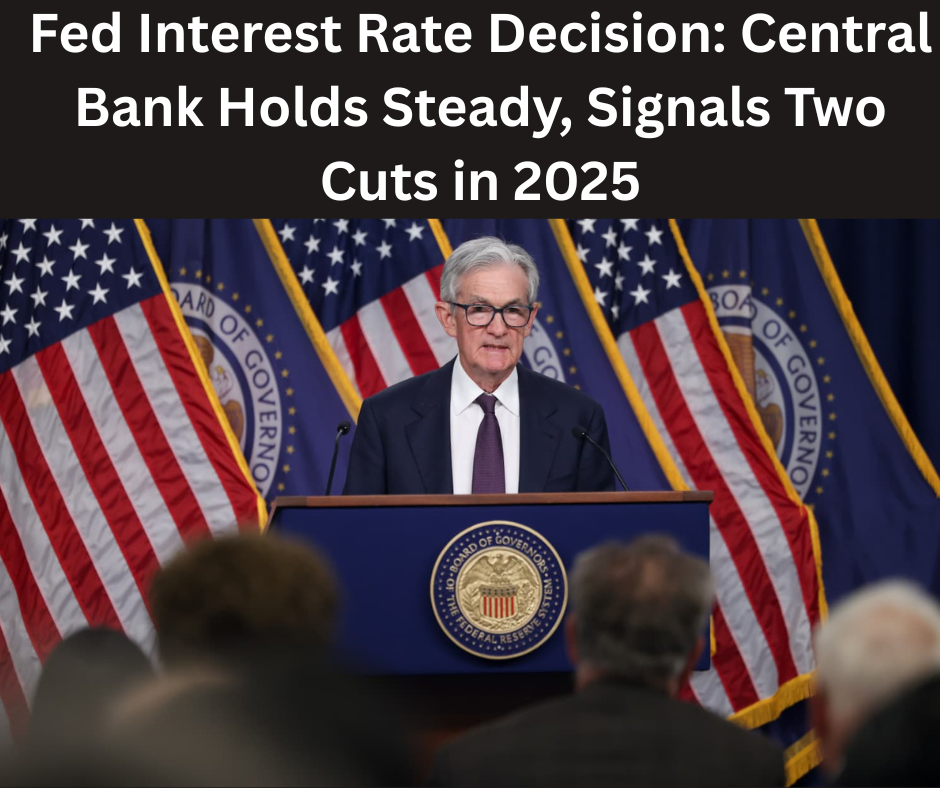Fed Interest Rate Decision: Central Bank Holds Steady, Eyes Two Cuts in 2025
In its latest monetary policy update, the Fed Interest Rate Decision Reserve announced that it will maintain current interest rates, opting to keep the federal funds rate between 4.25% and 4.5%. This Fed Interest Rate Decision aligns with market expectations and reflects ongoing concerns over inflation and economic growth. Despite holding steady, the Fed signaled the possibility of two rate cuts later in 2025, keeping investors and analysts on alert.
Why the Fed Interest Rate Decision Matters Now
The Fed Interest Rate Decision is particularly crucial at this juncture, as the U.S. faces mixed economic signals. Inflation remains above the 2% target, yet consumer demand is softening, and economic projections suggest slower growth ahead. The decision to pause further hikes offers the central bank breathing room to assess the long-term impacts of past tightening.
Fed’s “Dot Plot” Signals Two Rate Cuts
The central bank’s closely watched “dot plot” — a visual representation of policymakers’ rate expectations — revealed that the Fed still foresees two interest rate cuts by the end of 2025. However, the projections also removed one cut each from 2026 and 2027, signaling a slightly more cautious outlook beyond next year. This reflects the Fed’s wait-and-see approach amid a still-uncertain economic environment.
The “dot plot” also showcased a wide range of predictions among the 19 committee participants. Some expect no cuts at all this year, highlighting how divided the views are within the Fed.
Economic Projections: Growth Down, Inflation Up
Updated projections from the Fed painted a picture of slowing growth and persistent inflation. The gross domestic product (GDP) is expected to grow at just 1.4% in 2025, a 0.3 percentage point decline from the previous estimate. Simultaneously, the personal consumption expenditures (PCE) price index — the Fed’s preferred inflation gauge — is forecasted to rise to 3%. Core PCE, which excludes food and energy, is expected to climb to 3.1%.
These forecasts reinforce the importance of the current Fed Interest Rate Decision, which balances concerns about inflation with fears of an economic slowdown.
Fed Chair Powell Urges Patience
In a post-decision press conference, Fed Chair Jerome Powell explained the rationale behind holding rates steady. He noted that “now is the time to wait and gather more data before making further policy adjustments.” Powell emphasized that while inflation has declined somewhat, it remains elevated, and the full effects of tariffs and global conflicts on prices are still unfolding.
The Fed Interest Rate Decision reflects this cautious stance. Powell’s comments also suggested that the Fed is unlikely to act hastily, preferring to observe how the economy evolves over the coming months.
Trump Criticizes the Fed Over Rates
Former President Donald Trump did not hold back criticism, once again calling for dramatic rate cuts. Earlier in the day, Trump labeled Powell “stupid” for not slashing rates by at least 2 percentage points and even suggested he could run the central bank better himself.
While Trump’s comments hold no sway over Fed policy, they reflect growing political pressure as the 2024 election season approaches. However, the Fed Interest Rate Decision remains independent, based on data and long-term economic stability rather than political noise.
Tariffs and Global Tensions Add Complexity
One of the key reasons behind the Fed’s cautious approach is the uncertainty stemming from global trade tensions, particularly tariffs. Powell acknowledged that while some price increases linked to tariffs have started to appear — especially in consumer electronics — the full impact may not be felt until later this year.
The Fed Interest Rate Decision takes into account potential inflationary pressures from tariffs as well as the conflict in the Middle East, especially tensions involving Iran and Israel, which could lead to higher energy prices.
Labor Market Weakening, Spending Declining
Recent data from the labor market further supports the Fed’s current stance. Layoffs are increasing, long-term unemployment is creeping upward, and consumer spending has started to decline. Retail sales fell nearly 1% in May, and the housing market is cooling, with housing starts hitting a five-year low.
All these indicators add weight to the Fed Interest Rate Decision to hold rates for now, while leaving the door open for cuts later in 2025.
Government Debt Pressure and Budget Concerns
Another major backdrop to this decision is the ballooning U.S. national debt, which now exceeds $36 trillion. Interest payments on this debt are projected to hit $1.2 trillion in 2025, becoming the government’s third-largest expenditure after Social Security and Medicare.
Higher rates mean greater interest costs, further pressuring the federal budget. While the Fed Interest Rate Decision is not made with fiscal policy in mind, its implications on debt servicing costs are significant and increasingly debated.
Conclusion: What’s Next After the Fed Interest Rate Decision?
The latest Fed Interest Rate Decision offers a snapshot of a central bank walking a tightrope. It must tame inflation without stalling economic momentum, all while navigating global uncertainty and political pressure.
With two rate cuts still projected for 2025, the Fed has signaled flexibility — but it remains data-dependent. Investors, businesses, and households alike will be watching every speech, forecast, and inflation report closely as the year unfolds.
Read more: Real Madrid vs Al Hilal
